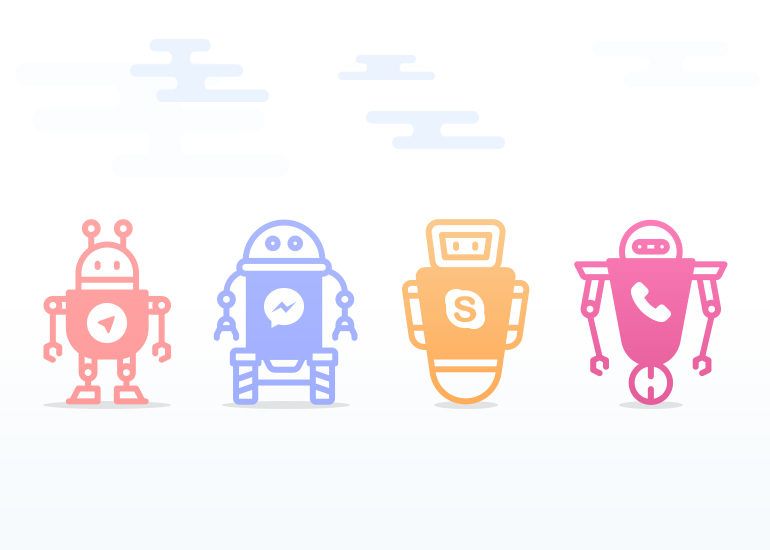An Oracle survey found that by 2020, around 80% of businesses will be leveraging the technology. From increasing sales to speeding up response times to personalizing digital experiences, chatbots are ubiquitous in business and are positively impacting consumer engagement across a range of industries, from retail to finance.
Chatbots open better paths to ecommerce. This hybrid of retail and conversation is what many refer to as conversational commerce. Conversational commerce is about delivering convenience, personalization, and decision support through a chatbot and allows brands to provide differentiated experiences to the customers. They can converse with a bot to shop for things, rather than visiting a website and going through the entire process of searching items, adding them to the shopping cart, checking out and paying the bill. Just a nudge from a bot can help boost the conversion of searches to sales and build a rapport with people who might not know what they want.
Chatbots and conversational commerce offer a great opportunity to improve the customer experience. But the quality of that experience is not a given. Building a chatbot for the sake of having a chatbot will result in an ineffective platform, leading to delayed or erroneous interactions. Many brands, unfortunately, lack a clear conversational commerce strategy and miss the mark when it comes to designing the script for seamless, delightful and efficient conversations.
The first step is to ensure that the prompts your chatbot delivers personalized and relevant. One must first understand what goes on behind the technology:
Natural Language understanding (NLU): These are algorithms that can understand human conversations by interpreting language. This involves understanding the subject of the conversation, the question asked related to the subject being discussed, the keywords used in the conversation, the sentiments expressed in the course of the conversation and so on.
Conversational understanding: The logic of conversations. In other words, what defines the construct of the conversation. This can be defined as use cases that define conversations in a given domain. In conversations, the context can change very quickly and responses cannot be restricted to menu options. Also, natural language interpretations of user questions need not always be accurate. In other words, the user question can be ambiguous.
Channels: This refers to the mechanism through which a user communicates with a chatbot. For example, Skype, Facebook messenger, Web chat, Digital assistants like Alexa and so on.
Designing a Conversational Chatbot
Conversations should be designed in a manner that they should not only convey information to the end user but also be engaging enough. This helps the end user take decisions easily and quickly without thinking too much about how to respond next.
The flow of conversation plays a crucial role in having a good user experience. Conversations should be designed in such a way that it gives a natural and enjoyable experience to the user. To maintain a proper flow of conversation, companies should be able to predict what the user is going to ask next and then design conversations that would trigger an appropriate reaction from said response. It is important to provide a free-flowing conversation to support all kinds of natural language variations, as humans expect chatbots to converse normally like a messaging application.
Here is your Do and Don’t checklist that you can reference when designing or re-evaluating your conversational chatbot.
Do’s for Designing a Conversational Chatbot
- Brevity: The main purpose of using a chatbot is to get the things done quickly and therefore every word in the conversation counts. Users should be able to use abbreviated languages that they use in their normal conversations. Chatbot conversations should be designed in such a way that it can interpret a variety of dialects used by the user.
- Clarity: Each message that a bot delivers should clearly give out the intended information to the user. In the bot’s response-message, make sure that the user is not overwhelmed with multiple messages and calls to action.
- Humanity: Users like to talk to a human rather than a machine. Use of natural language and expressions in conversations helps users feel that they are talking to a human.
- Personality: A bot is the extension of a brand’s personality, so it should reflect and deliver similar values and character. One of the easy and simple ways is to name the chatbot in a way that it relates to its functionality. For example, U.S. immigration department has developed a chatbot named ‘Emma’ who can help people find the immigration information they need. Emma is named after Emma Lazarus, who wrote the poem on helping immigrants at the base of the Statue of Liberty.
Don’ts for Designing a Conversational Chatbot
- Ambiguity: While designing, it’s important to avoid open-ended questions or statements. The responses designed for a bot should be specific and should help the user avoid misinterpretations.
- Complexity: People mainly use chatbots to perform a certain set of tasks in an easier, quicker and convenient manner. Make sure that it takes fewer steps than the conventional method. If chatbots add complexity, then it will probably become redundant.
- Rigidity: Every user may have a different way of conversing and hence the bot should not have a very specific flow of conversation. Make sure that the bot is designed in such a way that it can adapt to conversations and react intelligently.
- Totality: Conversations should be designed in such a way that it should be able to fulfill the key business needs, rather than catch-up call, for all the queries that a user might ask.
Chatbots give brands an opportunity to build, manage and maintain fruitful relationships with their customers. While designing, make sure that the personality, tone and manner fits perfectly with the user and with the specific situation in which the user is interacting.
With this tailored approach, you’ll see ROI fast and reap the benefits of conversational commerce.


